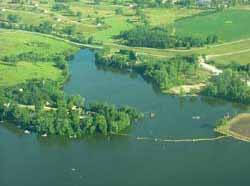The Capital Times :: SATURDAY EXTRA :: 3B
By Bill Novak The Capital Times
Gruber’s Grove Bay on Lake Wisconsin might have to be dredged again, after the state Department of Natural Resources discovered mercury in several sediment samples taken from the bay were still more than 20 times higher than acceptable levels set by the DNR.
Sediments in the bay were contaminated with mercury, methyl mercury, copper, lead and other pollutants from the Badger Army Ammunition Plant, directly northwest of the bay. Gruber’s Grove Bay is near Wisconsin 78 about a mile upstream from the Riverview Dam on the Wisconsin River.
The Army, which owns the Badger site, contracted to have more than 88,000 cubic yards of contaminated sediments dredged from the bay in 2001 after extremely high levels of mercury and other metals were found in the sediments by the DNR in 1999.
DNR technicians took new samples of sediments this winter and found high levels of mercury remained.
“None of the samples we collected met the established cleanup goal for Gruber’s Grove Bay,” said DNR hydrogeologist Steve Ales.
The DNR’s cleanup level guidelines call for mercury levels to be no higher than 0.36 parts per million (ppm) in the sediments.
Of 12 samples taken from the bay in February, 2003, the highest level was 8.09 ppm and the lowest was 0.38 ppm; only one other sample was below 1.0 ppm and three others were above 7.4 ppm.
DNR and Badger officials will discuss their findings, and how the Army and DNR will try to deal with the ongoing contamination problem, at a meeting Monday night in Prairie du Sac of the Badger Army Ammunition Plant Restoration Advisory Board.
The meeting starts at 7 p.m. in the River Arts Center, 105 Ninth St., next to Sauk Prairie High School.
“It’s frustrating,” Ales said. “The data (from the new samplings) didn’t come back as we hoped.”
When the sediments were first tested, Gruber’s Grove Bay was deemed as having the highest concentration of mercury ever found in sediments of Wisconsin waters, with levels approaching 24 ppm. The second-highest level ever found in the state was 7.7 ppm in the Fox River in Green Bay; the new samples from Gruber’s Grove Bay would now be the second-highest mercury levels in sediments ever found in the state.
Ales stressed that the high metal levels don’t pose a human health risk, if someone comes in contact with the sediments while swimming or wading in the bay.
Several dozen people live around the 25-acre bay; there’s no stream or brook flowing into the bay, but about 25 million gallons of wastewater per day from the Badger plant drained into the bay all the years the plant was making ammunition propellant during World War II and the Korean and Vietnam wars.
Laura Olah, executive director of Citizens for Safe Water Around Badger, said her group will push to have the rest of the contaminated sediments removed so the mercury levels drop below the DNR’s own cleanup goals.
“We’ve got a problem, so how do we work it out?” Olah said. “We need to make sure the DNR reaches the cleanup goals.”
Badger installation director Joan Kenney couldn’t say if more dredging would be done in Gruber’s Grove Bay, but she did say more sampling would be done.
“Preliminary results indicate some mercury remains in the sediments, so we’ll have the Army contractors do more sampling of the bay,” she said.
DNR waste program supervisor Mike Degen said Gruber’s Grove Bay is an important asset to the residents living on the bay and to others using Lake Wisconsin.
“We at the DNR will continue to work with the Army to evaluate the problem and make decisions regarding more investigations that may be needed for Gruber’s Grove Bay,” Degen said.
Ales said the bay is the only part of Lake Wisconsin affected by the high levels of mercury in the sediments. Fish samples taken from the bay also showed some mercury, but at acceptable levels for consumption.
Olah said she wants the Army to clean up Gruber’s Grove Bay before it pulls out of the Badger site; the 7,354 acres were mothballed years ago by the Army and the acreage is to be split between the DNR, the Ho-Chunk nation and the U.S. Department of Agriculture’s dairy forage research center.
Gruber’s Grove Bay is just one small part of the massive multimillion-dollar cleanup effort that has gone on since the early 1990s at the Badger plant.
Dozens of landfills, ponds and dumping grounds are slated to be decontaminated, and hundreds of buildings inspected and either decontaminated or torn down, before the site is turned over to the three new landholders.
madison.com is operated by Madison Newspapers Inc., publishers of the Wisconsin State Journal, The Capital Times, Agri-View and Apartment Showcase. All contents Copyright ©, Madison Newspapers, Inc. All rights reserved.

